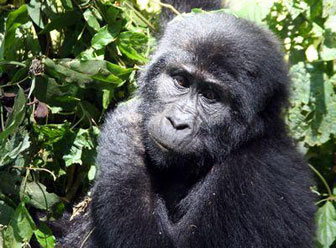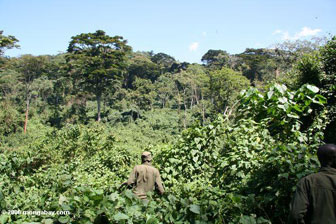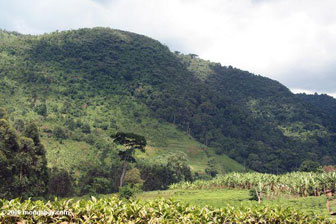Rare mountain gorillas in Uganda on the increase
Rare mountain gorillas in Uganda on the increase
Rhett A. Butler, mongabay.com
April 20, 2007

Juvenile gorilla in Bwindi (top), in search in gorillas in Bwindi (middle), adult male silverback gorilla (second middle), border of Bwindi Impenetrable National Park. Photos by Rhett A. Butler |
Highly endangered mountain gorillas in Uganda are increasing, reports a new census by the Uganda Wildlife Authority, the Wildlife Conservation Society, the Max Planck Institute of Anthropology and other groups.
The population of gorillas in Bwindi Impenetrable National Park has increased from 320 in 2002 to 340 today. A 1997 study found 300 gorillas, indicating that the park population has increased by 20 percent over the past decade. Aggressive conservation measures have been the key say researchers.
“This is great news for all of the organizations that have worked to protect Bwindi and its gorilla population,” said Wildlife Conservation Society researcher Dr. Alastair McNeilage, who is also the director of the Institute of Tropical Forest Conservation in Bwindi. “There are very few cases in this world where a small population of a endangered primates is actually increasing.”
Gorilla conservation has been a particularly high priority in Bwindi, where well-trained guides lead small and carefully supervised groups of tourists who pay more than $300 each for a permit to see the gorillas. The efforts have provided some compensation for communities around the park who have had to give up their right to cut timber and harvest game from the protected forest. Four of the 30 family groups are “habituated for tourism, or conditioned to tolerate the presence of humans for short durations,” according to WCS.
The news comes after surveys by the Dian Fossey Gorilla Fund International in the Democratic Republic of Congo (DRC) found that populations the “eastern lowland” gorilla, known more properly as Grauer’s gorilla (Gorilla beringei graueri), are also increasing. Meanwhile the last census of the Virunga gorilla population in neighboring Rwanda 2003 found 380 gorillas, up from 324 individuals counted in the previous census in 1989. The new census puts the global population of wild mountain gorillas at 720 individuals.
However not all news for gorillas is good. In Central Africa recent studies indicate that Ebola outbreaks have killed perhaps 25 percent of the world’s less endangered western lowland gorillas.
Still the results from Uganda are encouraging. The census used genetic samples from fecal specimens as well as traditional methodologies such as counting trails and nests
Elsewhere in Uganda, controvery continues to rage over the fate of Mabira forest, a protected reserve that president Yoweri Museveni has allocated for a sugar cane plantation.
This article used quotes and information from a WCS news release

















